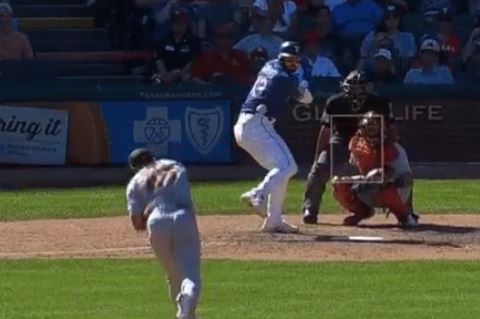How Can Anyone Possibly Hit Jordan Hicks?

The average fastball in 2019 registers 92.9 mph, which is to say about half of them are slower and half are faster. The majority of heaters will flash 91-95 mph. This is boring.
Whether it’s a drag race, a sprint, or a fastball, we care not for the average. The maximum is all that matters. Google “Ussain Bolt speed.” The immediate result is 27.8 mph- the fastest any human being has ever ran in the history of our species. Does anyone know Bolt’s average speed? Of course not! Who cares? Our only interest is the fastest recorded outcome. It’s human nature.
Here at OTBB, we love fast pitches. We’ll get to the subject of this piece in a second, but for a while now Aroldis Chapman has been at the top of the velocity game and we’ve written about him a lot. We’ve called for Chapman to pitch more and to win awards. We’ve compared him to his polar opposite and done an in depth examination of his single best pitch ever.
Our nature applies to fastballs as well. You’d be fortunate to see a fastball reach 98 mph in a given game, and you’d surely take notice. 100 mph is a paramount accomplishment. It’s Chuck Yeager breaking the sound barrier or Roger Bannister’s four-minute mile.
Yet, once a barrier is broken it’s easier for others to follow. 15 pitchers have achieved triple digits at least once this season. Most major leaguers have probably seen a 100 mph fastball in their lives.
But there’s only one Jordan Hicks.
Faster than Fast
The Cardinals reliever has topped 100 mph 141 times this year: 47.3 percent of his total pitches. He’s been clocked as fast as 104.2, maybe seven or eight mph faster than the fastest pitch a batter sees in a normal day! Just look at what he did to poor Joey Gallo:
Gallo strikes out a lot, but it doesn’t matter. It could’ve been Tony Gwynn or Ichiro in the box; the result would’ve been the same. Nobody catches Ussain Bolt when he’s at his best.
Watching the insane nastiness above, it’s fair to wonder how anyone can make contact against Hicks whatsoever. He’s enjoyed a pretty decent start to the 2019 season, with his 4.24 ERA belying a 2.99 FIP. But how is it possible that he has any ERA at all?
The Gallo at bat actually came in the middle of one of Hicks’ worst outings of the season: May 19 against the Texas Rangers. On the same day he displayed such unparalleled dominance, he was most fallible. Let’s look closer at the outing to find out how this could possibly happen.
Eighth Inning
Jordan Hicks entered the game in the eighth inning with the Cardinals trailing 3-2. Andrew Miller had surrendered the go-ahead run on a Danny Santana home run earlier in the frame, then retired the next two batters.
Logan Forsythe was Hicks’ first opponent with two outs and no one on. The at bat began with an 86.3 mph slider- a joke compared with what would follow. Three of the next four pitches were sinkers: 102.6, 103.0, and 102.4 mph. With Forstyhe sufficiently off balance, Hicks returned to his slider for the decision pitch.
This is not a well-struck baseball. All the same, it’s a single in the books, having landed just far enough away from Hicks that even his own fastball to first base couldn’t beat Forsythe. It’s just as well for the batter that he got a slider to “hit.” The 103.0 mph fastball was probably the fastest pitch he had ever seen.
Nomar Mazara followed, and Hicks stepped on the gas. The five pitches he saw were 103.5, 102.7, 101.8, 103.5, and 102.8. Even more miraculous is that Mazara made resounding contact with the last one!
The exit velocity of 104.6 mph somehow surpassed the pitch velocity! This is one of the most solidly struck baseballs of the season for Mazara- he achieved 104 mph exit velocity 28 times in 189 plate appearances. Again, all five of these pitches were probably the fastest he had ever seen.
Unfortunately for him, Kolten Wong was well positioned to snare it for the final out. It is a great unfairness that Forsythe’s tapper is a hit and Mazara’s scorcher is not. Alas.
Ninth Inning
Hicks remained in the game for the bottom of the ninth with the score now tied, 3-3. The first batter was Hunter Pence, who clearly did not fancy a prolonged stay. Eager to be done with the unpleasantry of facing the hardest thrower in the world, he swung at the first pitch: a 100.5 mph sinker.
By slapping a grounder to first baseman Paul Goldschmidt, Pence tried to exploit the shift. It didn’t quite work out, but his demonstration of directional hitting is unbelievable. This was probably the fastest pitch he had ever seen.
The next batter was Joey Gallo, and you already know how that ended. The same gif is reposted below because, like the first time you saw The Matrix, you just can’t comprehend the effects you’re watching.
The full at bat included five pitches: four sinkers ranging 102.1-102.5 mph and an 87.6 mph slider. HE TAKES 15 MPH OFF HIS SLIDER AND IT’S STILL 87.6! The bat never left Gallo’s shoulder. These were probably the fastest pitches he had ever seen.
The final batter of the inning was Asdrubal Cabrera. Hicks fell behind in the count, missing with a 102.4 mph sinker and an 86.1 mph slider. Then, Cabrera fouled off a 102.1 mph sinker. He fouled it off! Another sinker missed the plate at 102.6 mph. Then came the deciding pitch:
Cabrera PULLED (!) a 102.4 mph sinker to the second baseman Kolten Wong. He got the bat head out in front of 102! Aside from the one immediately preceding, this was probably the fastest pitch he had ever seen.
Tenth Inning
Since Jordan Hicks breezed through the ninth inning so easily, manager Mike Shildt decided to let him begin the tenth. The Cardinals scored in the top of the inning and held a 4-3 lead. Short relievers often lose velocity when throwing multiple innings. Hicks did not.
Rougned Odor led off for the Rangers. Hicks alternated sinkers and sliders: 100.0, 87.3, 102.0, and 87.8. On a 2-2 count, Hicks tried to finish him off with high heat.
This was no cheap single. Odor turned on a 102.4 mph blazer and drilled it to right-center. The ball departed at 95.5 mph and landed 301 feet away. With an xBA of .310, this was the best-struck ball against Hicks all day. It still had less than 50 percent chance of falling in for a hit, but sometimes the unexpected happens. This was the fastest pitch of the at bat, and probably the fastest pitch he had ever seen.
Next in line was Danny Santana, who worked a seven-pitch walk. To do so, Santana fouled off an 87.6 mph slider on a 3-2 count, which was more than 13 mph slower than any of the previous five pitches! Here’s ball four:
Santana has a career walk rate of 4.1 percent. To put that into context, there are only nine qualified hitters with a lower walk rate this season. He swings more freely than a 1970s key party.
This is where Hicks’ velocity works against him. That pitch was nowhere near the strike zone, but Santana has undoubtedly swung at worse pitches, especially with two strikes. However, at 102.7 mph, the 34th pitch of the outing was Hicks’ fastest since the Mazara at bat in the eighth inning. Santana, who defaults to swinging at anything, didn’t have time to react. It was probably the fastest pitch he had ever seen.
With no outs and the tying and winning runs on base, Willie Calhoun pinch hit for Jeff Mathis. Imagine spending nine-and-a-half innings on the bench with nothing to do, just sitting still and watching for three hours. Then Chris Woodward, the sadistic manager, tells you to grab a bat against Jordan Freaking Hicks, who throws at least three mph harder than anyone in your mostly-triple-A world.
On a 1-1 count, Calhoun fouled off a 102.7 mph sinker, posted here so he can show his grandkids someday.
Being a young player, Calhoun had never faced Hicks before. Therefore, we can say with confidence that this was definitely the fastest pitch he had ever seen. AND HE MADE CONTACT!
For some inexplicable reason, Jordan Hicks went to his slider for the next two pitches, the last of which was lined into right field for a single. Odor scored from second, tying the game once again.
Carlos Martinez relieved Hicks, then intentionally walked Shin-Soo Choo to load the bases. Forsythe struck out, but Mazara hit the game-winning sacrifice fly.
The Bad Jordan Hicks
Hicks’ final line was 1 1/3 innings, eight batters faced, three hits, one walk, one strikeout, and two earned runs. He took the loss.
Again, this was Jordan Hicks at his worst. That’s not even true. He sailed through the eighth and ninth innings, blemished only by the Forsythe dribbler. Shildt gambled that he would retain effectiveness after sitting through the top halves of two innings. In fact, this probably only could’ve happened in an AL park; otherwise, Hicks likely would’ve been removed for a pinch hitter.
In just this one game, Hicks through 28 pitches north of 100 mph, 26 at least 101, and 20 at 102. Only Marlins reliever Tayron Guerrero has thrown more 100 mph in the 2019 season than Hicks threw that day. No pitcher in baseball has thrown as many pitches at 101 all year. Forget about 102; Guerrero reached that velocity just once, and no one else has been there at all.
Yet, he still lost. In spite of his unmatched velocity, the Rangers still made enough contact to beat him. The miracle of throwing a baseball 103 mph sometimes yields to the miracle of modern hitters who are able to turn around the fastest pitches they’ve probably ever seen.
-Daniel R. Epstein


















